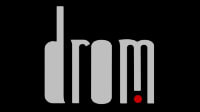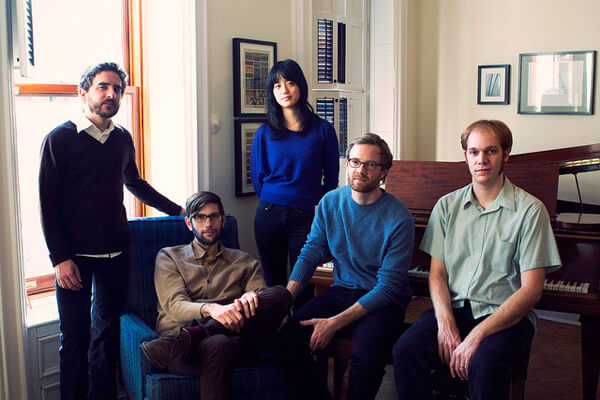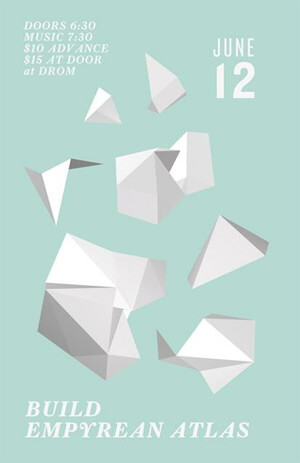 June 12th at Drom in NYC was a meeting of contemporary art music sensibilities with a rock/pop format. The result was something that was inviting, catchy, and groove-oriented but at the same time cerebrally satisfying. Build is a self-described indie-classical band whose compositions draw out the strength of each of its individual members and put infectious string melodies front and center. Empyrean Atlas’s music is driven by interlocking loops or guitars and saxophone with drums and building dynamics defining larger structures. Both groups gave enticing performances that were a solid departure from much of the drivel that abounds in the “art-rock” scene of New York.
June 12th at Drom in NYC was a meeting of contemporary art music sensibilities with a rock/pop format. The result was something that was inviting, catchy, and groove-oriented but at the same time cerebrally satisfying. Build is a self-described indie-classical band whose compositions draw out the strength of each of its individual members and put infectious string melodies front and center. Empyrean Atlas’s music is driven by interlocking loops or guitars and saxophone with drums and building dynamics defining larger structures. Both groups gave enticing performances that were a solid departure from much of the drivel that abounds in the “art-rock” scene of New York.

While Build, like plenty of other ensembles out there, can be described as a fusion of minimalism, contemporary jazz, and indie-rock, what sets them apart is their sense of melody and strong geometry as an ensemble. It was easy to find catchy elements in all of the pieces they performed, and these were memorable enough to stick with me well after the concert was over. While sometimes this was just a matter of a simple ostinato, Build distinguished themselves in their use of more extended melodies or distinct rhythmic motives that were effectively (in rock terms) “lead parts” rather than backgrounds. The dearth of melody is something of a weakness in much new art music, and while in some of Build’s pieces I found the use of repetition a bit overdone (I must confess I am not a huge fan of minimalism), the centrality of melodic motives in their music was a breath of fresh air.
Violinist Matt McBane (no relation to the movie character on the Simpsons), also the composer for the ensemble, has a keen sense for drawing out the strengths of each performer. The thumping and full-sounding double-bass work of Ben Campbell provided a firm foundation and contributed a jazz sensibility within a different musical framework. Andrea Lee’s cello lines, often the centerpiece of the compositions, exuding a self-assured simplicity. Moments of counterpoint between violin and cello were particularly enticing and made the music stand apart (in a good way) from a lot attempts at contemporary classical / rock crossover, though more of this sort of thing would have provided greater depth and tension to the music. The minimalist-styled piano parts and the larger structure provided by the drum set’s dynamic changes and accents completed the ensemble. The resulting geometry provided clarity of textures and defined roles for each instrument, sometimes working together in pairs as sections in a larger group, and with the resonance and lower registers of the cello and bass giving a solid sonic foundation.
This sense of geometry is much of what made Build work, essentially because it took what makes rock bands effective as ensembles and applied it to a new instrumentation. While much of its music was more on the tame side, my favorite piece performed that night was one that put a short harmonized melody in the piano together with pitch slides into dissonances between the cello and violin. The piano line, repeated throughout almost without variation, was emotionally depressing and musically full of gravitas. The violin and cello sometimes met in unisons but one or both slid into jarring and clear dissonances. The constant motion between the two instruments over the piano all at a quiet dynamic was deeply captivating. The drum set, beginning with accented crashes on each piano repetition and building into lengthier bursting rhythmic phrases, provided a contrast in energy with the pitched instruments and a larger structure to the otherwise repetitive motives. Here, Build’s ability to take simple materials and make something memorable and capable of connecting with its audience on an emotional and intellectual level was exemplary.

Empyrean Atlas is something of a combination of minimalism with afro-pop influences in a rock band format. The compositions, all by David Crowell, are based on interlocking ostinatos, often in odd meters, on two electric guitars, bass, and a saxophone. Each part in its own right had a captivating sense of horizontal melody, and put together wove a more complex tapestry. Within this repetition, the more unsettled drum set playing and use of dynamic changes served to create larger structure and motion. The musical language was quite original, though at times I could have used a stronger sense of groove (perhaps a greater sense of accent patterns would have served this purpose—the guitar-heavy instrumentation was not so conducive to this). I was quite pleased to hear new original music with electric guitars played with few pedals and less reliance on effects. Crowell’s compositions display a greater appreciation for the naked sound of electric guitar, and hearing this performance betrayed the fact that in the thirst for the latest gadgets, the great sound of an old fender amp has perhaps not yet been surpassed. The only use of guitar effects, in this case mostly sustain, was in moments of solo guitar in the middle of a couple pieces, in which the floating atmospheric passages provided a nice contrast to the constant ostinatos. While the interlocking repetitive parts were well-done, I could have used some extended melodies or more solo passages for variety’s sake. Like Build, Empyrean Atlas’s music was on the tame side for my tastes, though an exciting exception was in their last piece. Its astringent beginning and ending explored more dissonant harmonic territory, and its more off-kilter rhythmic lines broke out of the overall sense of regularity in their repertoire. The edgier sound provided a solid though unsettling ending to their performance.
Overall, this concert was proof that fusion of rock and contemporary classical, when done right, can produce music that is both artistically solid and audience pleasing. It also raises questions like what would be the best concert format for such music: sitting quietly at tables sipping wine, or standing, cheering when you feel like it, and moving when the grooves compel you to? Or, could the preponderance for using minimalist ostinatos these days make room for more melody and perhaps improvisation? And could this sort of music start to replace the third-rate art-rock and electronica that provides transplants to Brooklyn with a false sense of artsyness?
–-
David Pearson is a saxophonist residing in NYC.
























